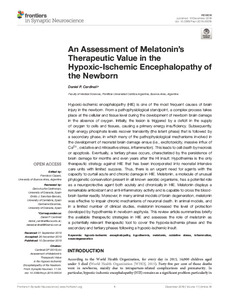Por favor, use este identificador para citar o enlazar este ítem:
https://repositorio.uca.edu.ar/handle/123456789/9646| Título: | An assessment of melatonin's therapeutic value in the hypoxic-Ischemic encephalopathy of the newborn | Autor: | Cardinali, Daniel Pedro | Palabras clave: | APOPTOSIS; MELATONINA; NEURODEGENERACION; ESTRES OXIDATIVO; HIPOTERMIA; ENCEFALOPATIAS; ISQUEMIA ENCEFALICA; ANTIOXIDANTES | Fecha de publicación: | 2019 | Editorial: | Frontiers Media | Cita: | Cardinali, D.P. An assessment of melatonin's therapeutic value in the hypoxic-Ischemic encephalopathy of the newborn [en línea]. Frontiers in Synaptic Neuroscience. 2019, 11:34. doi:10.3389/fnsyn.2019.00034 Disponible en: https://repositorio.uca.edu.ar/handle/123456789/9646 | Resumen: | Abstract: Hypoxic-ischemic encephalopathy (HIE) is one of the most frequent causes of brain injury in the newborn. From a pathophysiological standpoint, a complex process takes place at the cellular and tissue level during the development of newborn brain damage in the absence of oxygen. Initially, the lesion is triggered by a deficit in the supply of oxygen to cells and tissues, causing a primary energy insufficiency. Subsequently, high energy phosphate levels recover transiently (the latent phase) that is followed by a secondary phase, in which many of the pathophysiological mechanisms involved in the development of neonatal brain damage ensue (i.e., excitotoxicity, massive influx of Ca2+, oxidative and nitrosative stress, inflammation). This leads to cell death by necrosis or apoptosis. Eventually, a tertiary phase occurs, characterized by the persistence of brain damage for months and even years after the HI insult. Hypothermia is the only therapeutic strategy against HIE that has been incorporated into neonatal intensive care units with limited success. Thus, there is an urgent need for agents with the capacity to curtail acute and chronic damage in HIE. Melatonin, a molecule of unusual phylogenetic conservation present in all known aerobic organisms, has a potential role as a neuroprotective agent both acutely and chronically in HIE. Melatonin displays a remarkable antioxidant and anti-inflammatory activity and is capable to cross the blood-brain barrier readily. Moreover, in many animal models of brain degeneration, melatonin was effective to impair chronic mechanisms of neuronal death. In animal models, and in a limited number of clinical studies, melatonin increased the level of protection developed by hypothermia in newborn asphyxia. This review article summarizes briefly the available therapeutic strategies in HIE and assesses the role of melatonin as a potentially relevant therapeutic tool to cover the hypoxia-ischemia phase and the secondary and tertiary phases following a hypoxic-ischemic insult. | URI: | https://repositorio.uca.edu.ar/handle/123456789/9646 | ISSN: | 1663-3563 | Disciplina: | MEDICINA | DOI: | 10.3389/fnsyn.2019.00034 | Derechos: | Acceso abierto | Fuente: | Frontiers in Synaptic Neuroscience. 2019, 11:34 |
| Aparece en las colecciones: | Artículos |
Ficheros en este ítem:
| Fichero | Descripción | Tamaño | Formato | |
|---|---|---|---|---|
| assessment-melatonins-therapeutic-value.pdf | 625,45 kB | Adobe PDF |  Visualizar/Abrir |
Visualizaciones de página(s)
302
comprobado en 30-abr-2024
Descarga(s)
379
comprobado en 30-abr-2024
Google ScholarTM
Ver en Google Scholar
Altmetric
Altmetric
Este ítem está sujeto a una Licencia Creative Commons

